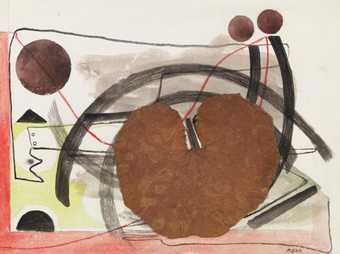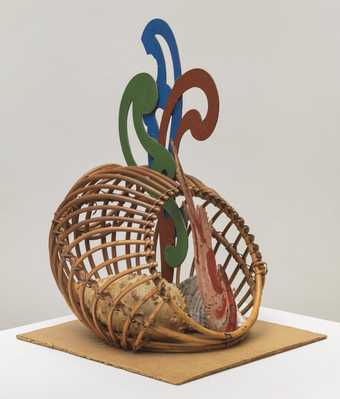
In Tate Britain
- Artist
- Eileen Agar 1899–1991
- Medium
- Terracotta, horn, bone and shells
- Dimensions
- Object: 420 × 340 × 230 mm
- Collection
- Tate
- Acquisition
- Presented by the Friends of the Tate Gallery 1990
- Reference
- T05818
Summary
Between 1928-30 Eileen Agar lived in Paris where she met Max Ernst (1891-1976), Joan Miró (1893-1983), and André Breton (1896-1966), among others. Although her acquaintance with the leading figures of European Surrealism manifested itself in the Surrealist strategies apparent in her own work during the 1930s, she did not subscribe to the radical politics of her European counterparts. In 1936 she was invited by Herbert Read and Roland Penrose to exhibit work at the International Surrealist Exhibition at the New Burlington Galleries, London. The notoriety of the exhibition raised Agar's public profile considerably and, in 1937, she was one of the few artists asked to submit work for the Fantastic Art, Dada and Surrealism exhibition held at the Museum of Modern Art, New York.
In the spring of 1939 Agar and her partner, Joseph Bard, moved to the vicinity of Toulon in the South of France. According to the artist, one day, while watching fishermen haul in their nets at Carquieranne, a small fishing port nearby, she noticed a Greek amphora broken into two pieces caught in one of the nets. This amphora, which she acquired from the fisherman, forms the central element of Marine Object. She had found the crustaceans and flotsam applied to the amphora two years earlier on a beach near Mougins, Côte d'Azur. On the base of the assemblage is a ram's horn that she had picked up in Cumberland. Describing the making of Marine Object as 'short work', Agar added, 'though it took me and the amphora a long time to attempt such a conjunction!' (Agar, p.144).
Agar had collected seemingly unremarkable ephemera found on the seashore and in various publications since childhood, but it was only in the mid 1930s that she began to incorporate these objects into her work. The surrealist practice of transformation of found objects through unexpected juxtapositions was for Agar, like collage, 'a form of inspired correction, a displacement of the banal by the fertile intervention of chance or coincidence' (quoted in Agar, p.147). Discussing the ephemerality of her assemblages and those of other Surrealists, Agar commented that the objects had been found 'at the behest of chance and went that way also' (Agar, p.140). While many of Agar's assemblages were made for a particular event, it is not known if Marine Object was.
Further reading:
Ann Simpson, David Gascoyne and Andrew Lambirth, Eileen Agar 1899-1991, exhibition catalogue, Scottish National Gallery of Modern Art, Edinburgh 1999, reproduced p.79, cat.no.54
Eileen Agar, A Look at My Life, London 1988, reproduced pl.24a
Toby Treves
November 2000
Does this text contain inaccurate information or language that you feel we should improve or change? We would like to hear from you.
Display caption
For Agar, the unexpected juxtaposition of found objects was ‘a form of inspired correction, a displacement of the banal by the fertile intervention of chance or coincidence’. In Marine Object she brings together part of a Greek amphora that she retrieved from a fisherman’s net in the south of France with crustaceans and flotsam gathered on a beach two years earlier, and a ram’s horn from Cumbria. Agar described the making of Marine Object as ‘short work... though it took me and the amphora a long time to attempt such a conjunction!’
Gallery label, January 2016
Does this text contain inaccurate information or language that you feel we should improve or change? We would like to hear from you.
Explore
- emotions, concepts and ideas(16,416)
-
- formal qualities(12,454)
-
- assemblage / collage(47)
- found object / readymade(2,631)
- vessels and containers(2,157)
-
- jar(113)
You might like
-
Eileen Agar The Reaper
1938 -
Eileen Agar Angel of Anarchy
1936–40 -
Eileen Agar Fish Basket
c.1965



